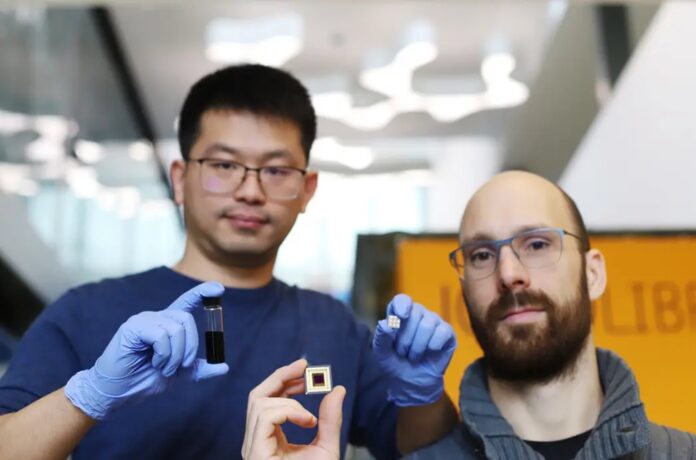Researchers at ICFO, led by Prof. Gerasimos Konstantatos, have developed high-performance infrared photodetectors and a shortwave infrared (SWIR) image sensor based on non-toxic colloidal quantum dots. These quantum dots, specifically phosphine-free silver telluride (Ag2Te), offer a solution-processed material platform for SWIR sensitivity without heavy metals like lead or mercury. This development paves the way for SWIR colloidal quantum dot technology in mass-market applications, addressing regulatory concerns related to hazardous substances in electronics.
Shortwave infrared (SWIR) light, invisible to our eyes, can enhance reliability and performance in high-volume computer vision applications like service robotics, automotive, and consumer electronics. SWIR-sensitive image sensors can operate effectively in challenging conditions such as bright sunlight, fog, haze, and smoke, offering eye-safe illumination sources and the ability to detect material properties through molecular imaging.
Colloidal quantum dots (CQD) based image sensor technology presents a promising platform for high-volume SWIR-compatible sensors. CQDs, nanoscale semiconductor crystals, offer a solution-processed material that integrates with CMOS, enabling access to the SWIR range. However, a significant obstacle lies in translating SWIR-sensitive quantum dots into a key enabling technology for mass-market applications, as they often contain heavy metals like lead or mercury, raising regulatory concerns.
The researchers in this study developed size-tuneable, phosphine-free silver telluride (Ag2Te) quantum dots, maintaining the favorable properties of traditional heavy-metal counterparts. This breakthrough clears the path for the integration of shortwave infrared (SWIR) colloidal quantum dot technology into high-volume markets.
Initially exploring the synthesis of silver bismuth telluride (AgBiTe2) nanocrystals for enhancing the performance of photovoltaic devices, the researchers unintentionally obtained silver telluride (Ag2Te) as a by-product. They recognized its strong and tuneable quantum-confined absorption, similar to quantum dots, and its potential for SWIR photodetectors and image sensors.
To address regulatory concerns, they focused on developing a new process to synthesize phosphine-free versions of silver telluride quantum dots, avoiding the detrimental impact of phosphine on the quantum dots’ optoelectronic properties relevant to photodetection.
In their innovative synthetic approach, the research team utilized different phosphine-free complexes, including tellurium and silver precursors. This method resulted in quantum dots with well-controlled size distribution and excitonic peaks spanning a vast spectrum. The newly synthesized quantum dots displayed remarkable performance, featuring distinct excitonic peaks surpassing 1500 nm. This achievement is unprecedented compared to previous techniques using phosphine-based methods for quantum dot fabrication.
The researchers incorporated these phosphine-free quantum dots into a laboratory-scale photodetector on a standard ITO (Indium Tin Oxide)-coated glass substrate to explore their potential further. This allowed them to characterize the devices and measure their properties.
Yongjie Wang, postdoc researcher at ICFO and first author of the study said, “Those lab-scale devices are operated with shining light from the bottom. Light comes from the top for CMOS-integrated CQD stacks, whereas the CMOS electronics take the bottom part of the device. So, the first challenge we had to overcome was reverting the device setup. A process that in theory sounds simple, but in reality proved to be a challenging task.”
Initially, the photodiode demonstrated low sensitivity to shortwave infrared (SWIR) light. In response, the researchers redesigned it by incorporating a buffer layer, leading to a substantial improvement in performance. The modified SWIR photodiode now boasts a spectral range from 350nm to 1600nm, a linear dynamic range exceeding 118 dB, a -3dB bandwidth surpassing 110 kHz, and a room temperature detectivity of 1012 Jones.
Gerasimos Konstantatos, ICREA Prof. at ICFO and leading author of the study, said, “To the best of our knowledge, the photodiodes reported here have for the first time realized solution-processed, non-toxic shortwave infrared photodiodes with figures of merit on par with other heavy-metal containing counterparts.”
“These results further support the fact that Ag2Te quantum dots emerge as a promising RoHS-compliant material for low-cost, high-performance SWIR photodetectors applications.”
Having successfully developed a heavy-metal-free quantum dot-based photodetector, the researchers collaborated with Qurv, an ICFO spin-off, to showcase its potential. They constructed a shortwave infrared (SWIR) image sensor as a case study, integrating the new photodiode with a CMOS-based read-out integrated circuit (ROIC) focal plane array (FPA). This marked the first proof-of-concept for a non-toxic, room temperature-operating SWIR quantum dot-based image sensor.
The team tested the imager by capturing images of a target object, demonstrating its functionality in the SWIR. Notably, they could image the transmission of silicon wafers under SWIR light and visualize the content of plastic bottles opaque in the visible light range.
Gerasimos Konstantatos said, “Accessing the SWIR with a low-cost technology for consumer electronics will unleash the potential of this spectral range with a huge range of applications, including improved vision systems for the automotive industry (cars), enabling vision and driving under adverse weather conditions.”
“SWIR band around 1.35-1.40 µm, can provide an eye-safe window, free of background light under day/night conditions, thus further enabling long-range light detection and ranging (LiDAR), three-dimensional imaging for automotive, augmented reality and virtual reality applications.”
Journal Reference:
- Wang, Y., Lucheng, P. Schreier, J., Bi, Y. Black, A., Malla, A. Goossens, S., Konstantatos, G. (2023) Silver telluride colloidal quantum dot infrared photodetectors and image sensors. Nature Photonics. DOI: 10.1038/s41566-023-01345-3
